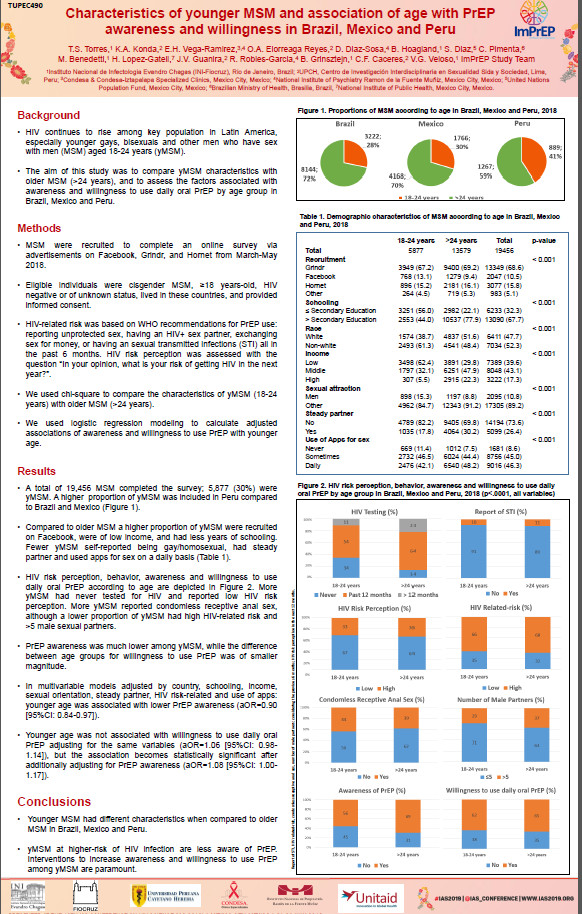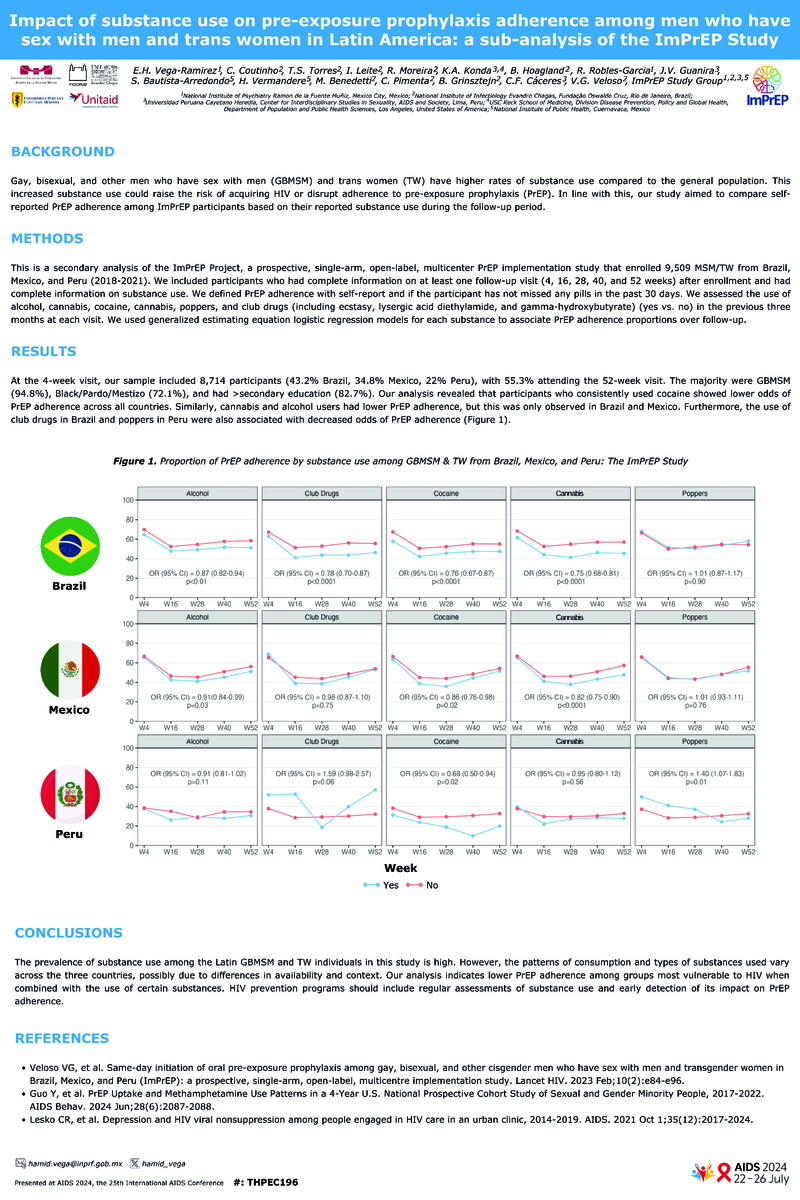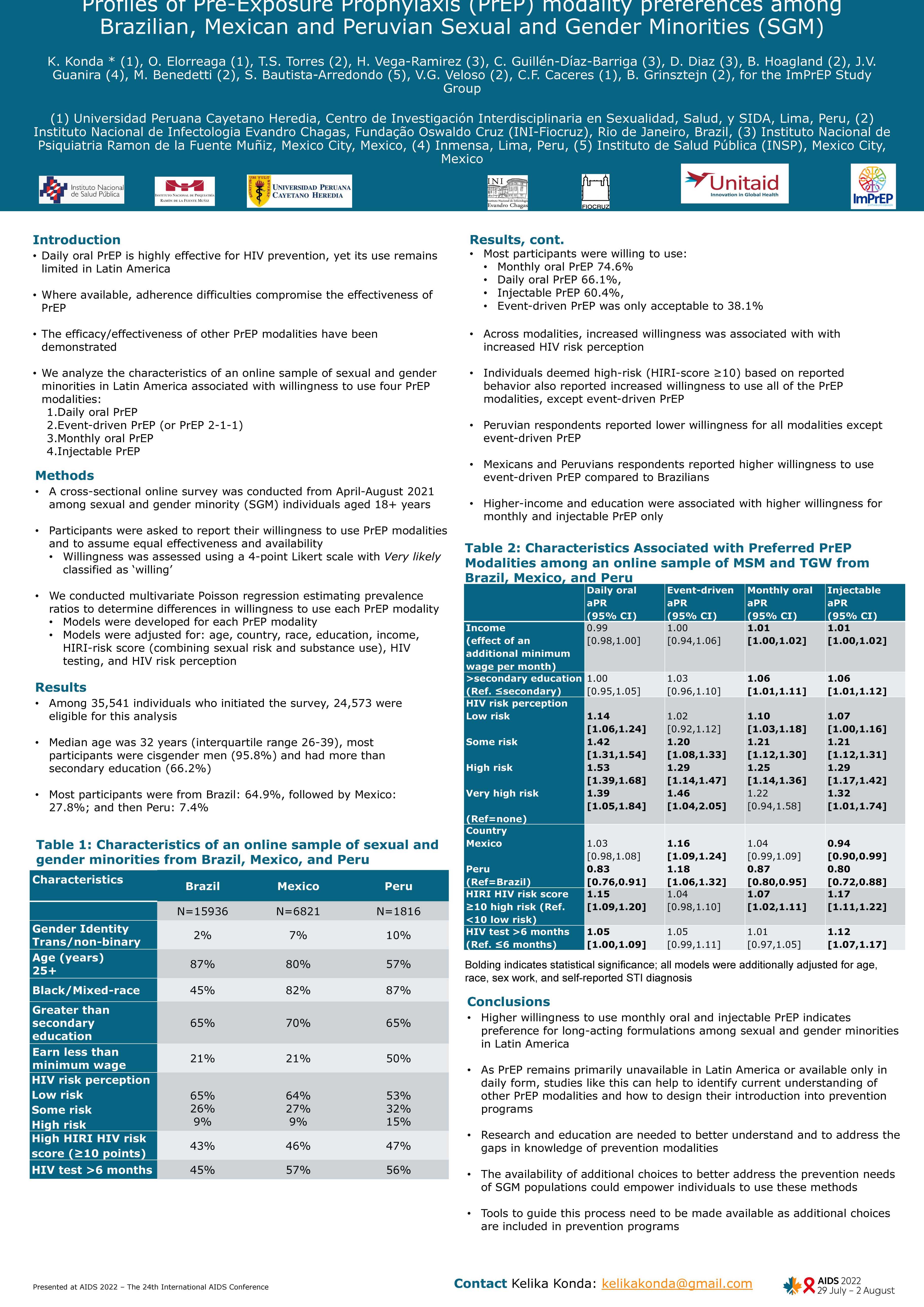Catálogo general VIH/sida

Characteristics of younger MSM and association of age with PrEP awareness and willingness in Brazil, Mexico and Peru
Resumen
Background: HIV continues to rise among key populations in Latin America, especially MSM aged 18-24 years (yMSM). We assessed the association between younger age and PrEP awareness and willingness among MSM from Brazil, Mexico and Peru. Methods: MSM were recruited to complete an online survey via advertisements on Facebook, Grindr, and Hornet from March-June 2018. Eligible individuals were cisgender men, =18 years-old, HIV negative or of unknown status, lived in these countries, and provided informed consent. HIV-related risk was based on WHO recommendations for PrEP use: reporting unprotected sex, having an HIV+ sex partner, transactional sex, or having an STI all in the past 6 months. We used chi-square to describe MSM according to age and logistic regression modeling to calculate adjusted associations with younger age. Results: From 19,456 MSM who completed the survey, 5,877(30%) were yMSM. Compared to older MSM (>24 years), a higher proportion of yMSM were recruited on Facebook (13% vs. 9%, p< .001), low income (62% vs. 30%; p< .001), less educated (=12 years; 56% vs. 22%, p< .001), fewer self-reported being gay/homosexual (85% vs. 91%; p< .001), had no steady partner (82% vs. 70%, p< .001), used apps for sex less frequently (daily; 42% vs. 48, p< .001) and never tested for HIV (34% vs. 14%; p< .001). Although yMSM had more HIV-related risk (34% vs. 32%, p< .001) and male sex partners (>5; 71% vs. 63%, p< .001), yMSM had less condomless receptive anal sex (56% vs. 61%, p< .001), lower HIV risk perception (67% vs. 64%, p< .001), lower PrEP awareness (56% vs. 69%, p< .001) and lower PrEP willingness (62% vs. 65%, p< .001). In multivariable model adjusted by country, education, income, sexual orientation, steady partner, HIV risk-related and use of apps: younger age was associated with lower PrEP awareness (aOR0.90 [95%CI:0.84-0.97]). Younger age was not associated with PrEP willingness adjusting for the same variables (aOR1.06 [95%CI:0.98-1.14]), but the association becomes statistically significant after additionally adjusting for PrEP awareness (aOR1.08 95%CI:1.00-1.17]). Conclusions: Although at higher HIV risk, yMSM are less aware of PrEP. Interventions to increase PrEP awareness and willingness among yMSM are paramount.
Autoría:
TORRES, Thiago S.; KONDA, Kelika Anne; VEGA RAMÍREZ, E. Hamid; ELORREAGA REYES, Oliver A.; DÍAZ SOSA, Dulce; HOAGLAND, Brenda; DÍAZ, S.; PIMENTA, Cristina; BENEDETI, Marcos; LÓPEZ GATELL, H.; GUANIRA CARRANZA, Juan Vicente; ROBLES GARCÍA, Rebeca; GRINSZTEJN, Beatriz; CÁCERES PALACIOS, Carlos Fernando; VELOSO, Valdilea G.
Autoría institucional: ImPrEP Study Team
Autoría institucional: ImPrEP Study Team
Ficha bibliográfica
- Año de publicación:
- [2019]
- Descripción física:
- [1] p.
- Formato:
- Folleto
- Tipo de documento:
- Coloquios y ponencias
- Notas:
- Póster presentado en la 10 IAS Conference on HIV Science (IAS 2019) celebrada en México DF del 21 al 24 de julio de 2019.
Contenidos relacionados
También te pueden interesar
-
Impact of substance use on pre-exposure prophylaxis adherence among men who have sex with men and trans women in Latin America: a sub-analysis of the ImPrEP Study
-
Profiles of pre-exposure prophylaxis (PrEP) modality preferences among Brazilian, Mexican and Peruvian sexual and gender minorities (SGM)
-
Are men who have sex with men at higher risk for HIV in Latin America more aware of PrEP?





